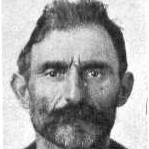
d: 1900
Cayetano Domingo Grossi
Summary
Name:
Cayetano Domingo GrossiNickname:
The Man of the BagYears Active:
1896 - 1898Status:
ExecutedClass:
Serial KillerVictims:
5Method:
Blunt force trauma / Strangulation / BurningDeath:
April 06, 1900Nationality:
Argentina
d: 1900
Cayetano Domingo Grossi
Summary: Serial Killer
Name:
Cayetano Domingo GrossiNickname:
The Man of the BagStatus:
ExecutedVictims:
5Method:
Blunt force trauma / Strangulation / BurningNationality:
ArgentinaDeath:
April 06, 1900Years Active:
1896 - 1898bio
Cayetano Domingo Grossi was born in 1854, believed to be of Italian (possibly Calabrian) descent, and lived in poverty in Buenos Aires, Argentina. By profession, he worked as a carter—hauling goods and trash with a horse-drawn wagon. Grossi lived in the Retiro neighborhood on Artes Street (now Carlos Pellegrini) with his partner Rosa Ponce de Nicola and her children from a previous relationship. The household included Rosa’s older daughters Clara and Catalina, along with three younger children from her relationship with Grossi.
The household, described by neighbors as reclusive and strange, appeared to maintain disturbing patterns behind closed doors. Testimonies later revealed that Grossi had been sexually abusing his stepdaughters Clara and Catalina, leading to multiple pregnancies.
murder story
The case of Cayetano Domingo Grossi broke into public view in May 1896, when a garbage collector found a burlap sack containing the dismembered body parts of a newborn, an arm, skull fragments, and legs. The investigation revealed that the child had died from a skull fracture. However, with no leads, the case went cold.
It wasn’t until May 5, 1898, that a second infant's body was discovered in a similar state, this time with signs of strangulation and burns. Forensic investigators noted that while the burns did not cause the baby's death, they were likely inflicted postmortem or during an attempted cover-up. Details about the burlap sack and the anise seeds found nearby led police to suspect a poor man of southern European descent. Their suspicion eventually narrowed down to Grossi.
Neighbors had noted that Grossi's stepdaughter Clara was recently pregnant, but the baby was never seen. Further investigation led to the Grossi household, where a search on May 10, 1898, uncovered another infant's body hidden in a tin can wrapped in rags. Grossi claimed the baby belonged to his son and that Clara had asked him to kill it.
Clara and Catalina eventually testified that they had been impregnated by Grossi himself. Grossi initially denied the abuse, blaming outside boyfriends, but soon confessed to killing multiple babies and burning the bodies. He admitted to personally assisting in the births, then either strangling the infants or incinerating them shortly afterward.
In total, Grossi confessed to murdering five of his newborn children, born through incestuous rape. The timeline suggested that some of the babies were strangled, while others were burned alive or shortly after death. His partner Rosa and stepdaughters Clara and Catalina were sentenced to three years in prison each for concealing the crimes, with Catalina’s sentence later reduced to two years. All three women blamed Grossi, claiming they were forced into silence by his threats and violence.
Grossi was tried and found guilty of all five infanticides. Judge Ernesto Madero sentenced him to death. On the morning of April 6, 1900, Grossi was blindfolded, tied to a chair, and shot by firing squad at 8:00 AM. His son Lorenzo, then six years old, refused to approach him. His daughter Teresita cried but also resisted hugging her father. The final shot was delivered by Second Lieutenant Emilio Lascano.